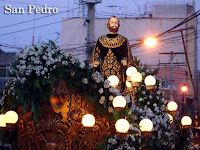
Aside from being one of the most solemn religious events in the Philippines, Holy Week or
Mahal na Araw is a colorful display of Philippine culture and religious fervor. Here are some cultural practices you should not miss:
Palm Sunday
Today is Palm Sunday so we won't be able to witness these events again until next year. There were unique palm processions in Sta. Isabel in Malolos, Obando and Baliwag in Bulacan; as well as in Gasan, Marinduque. In Sta. Isabel, an image of the
Humenta or Christ on a donkey joins the palm procession as women spread their
tapis or traditional aprons as the priest walks by. In Gasan, the priest himself rides a real pony on the way to church.
Holy Wednesday
Many procession are held on this day. Check out the folk Baroque images in the Laguna towns of Pakil, Majayjay and Paete. In Paete, it is said that the images for the Catholic Wednesday and Aglipayan Thursday processions move and speak in archaic Tagalog. In Pampanga, some of the best heirloom
carrozas are brought out in Betis, Sasmuan and San Fernando. Also check out the processions in Baliwag, Malolos, Barasoain (Malolos), San Pablo and Molo (Iloilo City).
Maundy Thursday
In churches around the country, the Mass of the Last Supper will be celebrated in the evening. After this Mass, the Blessed Sacrament is enshrined in an Altar of Repose or
monumento, and churches remain open for the
visita iglesia. But some people do the
visita iglesia while the sun is out though in order to see the lavish colonial churches in daylight. I have an old post on
visita iglesia suggestions at
Visita iglesia routes for Holy Thursday. But I'll have another entry on churches to visit soon.
Around the country, the chanting of the
pabasa continues. In San Fernando and Guagua, there are colorful
puni or
pabasa stations with a
fiesta atmosphere. Also check out the
cordero or Lamb of God rituals in Betis, Guagua, Pampanga and Morong, Rizal. A lamb sculpture made out of mashed potatoes or
kamote (sweet potatoes) is the center of this practice.
Good Friday
There is so much to see on this day. There are public self-flagellations in many towns around the country. In San Fernando, Pampanga; Pulilan and Hagonoy, Bulacan; and Navotas, they use wooden slats attached to ropes to whip their backs. In Hermosa, Bataan; Sasmuan, Pampanga; and Pakil, Laguna, flagellants use chains. In Kalayaan, Laguna penitents wear fronds and flowers. While in Infanta, Quezon, penitents wear hoods embellished with flowers to invoke fertility.
In Magalang, Pampanga and other parts of Pampanga, penitents crawl on the ground or carry crosses made out of banana trunks. In San Pedro Cutud in San Fernando, about a dozen penitents are nailed to wooden crosses after a traditional play called the
Via Crusis. Check out the entry
Good Friday in San Fernando, Pampanga to get detailed information on Good Friday practices in San Fernando.
The
moriones, with men dressed as Roman soldiers, are held in General Luna, Quezon; Pinamalayan, Oriental Mindoro; and Boac and Gasan, Marinduque. The one in General Luna is said to be the oldest
moriones event in the country. There is also amulet hunting and testing as well with shaman assemblies held such as those in Calabanga, Camarines Sur where hooded shamans pray at the Holy Bier at 5 a.m. In Pakil, Laguna, check out the
Turumba procession of the
Nuestra Senora de los Dolores de Turumba.
In the towns of Sta. Rita and Sasmuan in Pampanga; as well as Tayabas, Quezon and Boljoon, Cebu, the sermons on the Seven Last Words of Christ are followed by the
Tinieblas, a theatrical ritual marking the death of Christ with the banging shut of the church doors, the wailing of women and the hammering of church roofs to symbolize thunder. The body of Christ is brought down from the cross by two men dressed as Nicodemus and Joseph of Arimathea. In Boljoon and Sta. Rita, they are assisted by people dressed as the Marys and St. John who all deposit the image on the lap of a woman designated to be Mother Mary. She wails loudly for several minutes. In Sasmuan, the town orchestra plays the
Stabat Mater as a choir sings. This is followed by a public veneration of the image Christ's body or the
Sto. Entierro.
Some of the most lavish processions of the
Sto. Entierro are held in Lingayen, Pangasinan; San Fernando, and Guagua, Pampanga; Malolos and Baliwag, Bulacan; Binan and San Pablo, Laguna; and Argao and Carcar, Cebu. In Carcar and Sorsogon, Sorsogon, the
Soledad procession is held late at night.
 Visita iglesia to our Philippine churches has been a part of our lives as Catholic Filipinos. Every Holy Thursday, we visit seven churches, some fourteen, as we reflect on Christ's passion and death. I've done a whole lot of articles on Holy Week including Holy Week practices in the Philippines, which discusses Holy Week practices you could witness if you're at the right place at the right time.
Visita iglesia to our Philippine churches has been a part of our lives as Catholic Filipinos. Every Holy Thursday, we visit seven churches, some fourteen, as we reflect on Christ's passion and death. I've done a whole lot of articles on Holy Week including Holy Week practices in the Philippines, which discusses Holy Week practices you could witness if you're at the right place at the right time.






















































